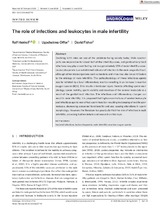| dc.description.abstract | Declining birth rates are one of the problems facing society today. Male counterparts are responsible for about half of the infertility cases, and genitourinary tract infections may play a contributing role in approximately 15% of male infertility cases. Leukocytospermia is an established indicator of infection in the male urogenital tract, although other microorganisms such as bacteria and virus may also be contributors to the etiology of male infertility. The pathophysiology of these infectious agents may be initiated by a local inflammatory reaction resulting in an increase in reactive oxygen species (ROS). This results in testicular injury, thereby affecting sperm morphology, sperm motility, sperm viability and elevation of the seminal leukocyte as a result of the genital tract infection. The infectious and inflammatory changes can result in male infertility. It is proposed that high concentrations of seminal leukocyte and infectious agents may affect sperm function resulting in clumping of motile spermatozoa, decreasing acrosomal functionality and also causing alterations in sperm morphology. | en_US |

